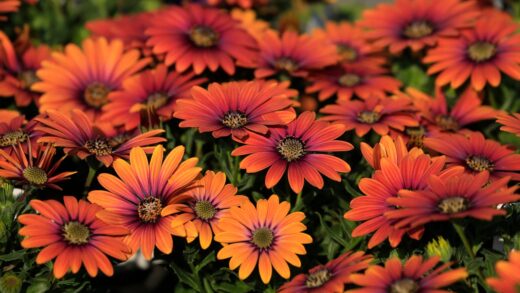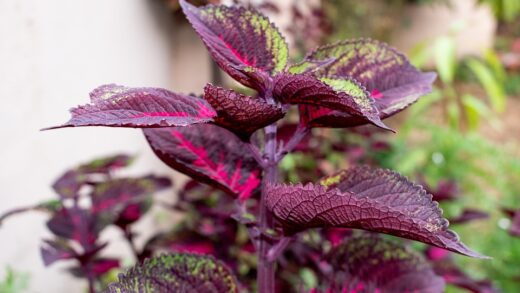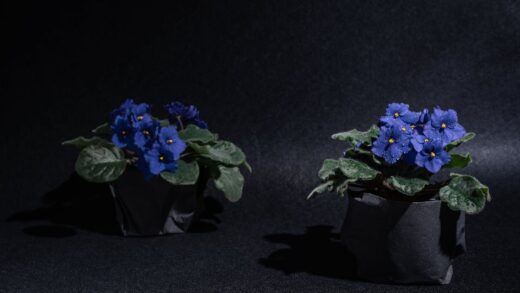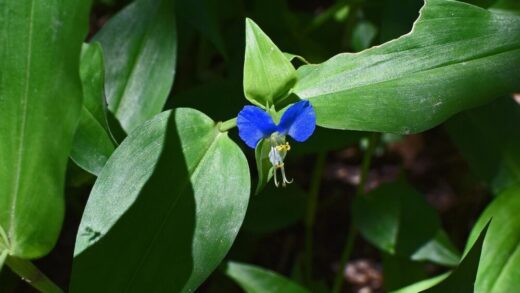To achieve the spectacular foliage that makes coleus a garden favorite, providing a steady and balanced supply of nutrients is essential. While these plants are not excessively heavy feeders, their rapid growth and the continuous production of vibrant leaves during the growing season deplete the nutrients available in the soil. Fertilization is the practice of replenishing these essential elements, ensuring the plant has the building blocks it needs for healthy development, robust structure, and, most importantly, intense and lasting color. Understanding what nutrients coleus require, when to apply them, and which type of fertilizer to use is key to unlocking the full genetic potential of these remarkable ornamental plants. An effective fertilization strategy supports the plant without overstimulating it, which can be just as detrimental as nutrient deficiency.
The primary nutrients required by coleus are the same as for most plants: nitrogen (N), phosphorus (P), and potassium (K). Nitrogen is arguably the most critical for coleus, as it is a major component of chlorophyll and is directly responsible for promoting lush, leafy growth. Phosphorus plays a vital role in root development, energy transfer, and flowering, while potassium contributes to overall plant vigor, disease resistance, and water regulation. A balanced fertilizer, where these three macronutrients are present in relatively equal proportions, is generally ideal for supporting the all-around health of the plant.
Coleus grown in containers have a greater need for regular fertilization than those planted in garden beds. The limited volume of soil in a pot contains a finite supply of nutrients, which are quickly used up by the growing plant and also leached out with each watering. For this reason, a consistent feeding schedule is crucial for containerized specimens. In contrast, coleus planted in a well-amended garden bed with plenty of rich organic matter will have access to a larger and more slowly released pool of nutrients, reducing the frequency with which supplemental fertilizer is needed.
The frequency of fertilization should be synchronized with the plant’s growth cycle. The most active period of growth for coleus is from spring through summer, and this is when they will benefit most from regular feeding. As autumn approaches and daylight hours shorten, the plant’s growth naturally slows down. During this time, fertilization should be tapered off and eventually stopped altogether for the winter months. Feeding a dormant or semi-dormant plant is unnecessary and can be harmful, as it can lead to a buildup of fertilizer salts in the soil that can damage the roots.
It is crucial to follow the application instructions on the fertilizer packaging carefully. Over-fertilizing is a common mistake that can have serious consequences. An excess of nutrients, particularly nitrogen, can lead to weak, stretched, or “leggy” growth, and can sometimes even cause the vibrant colors of the foliage to become less intense, with more green appearing. Furthermore, a high concentration of fertilizer salts in the soil can “burn” the delicate roots, impairing the plant’s ability to absorb water and leading to wilting, browning of leaf edges, and in severe cases, plant death. It is often safer to err on the side of caution and apply fertilizer at half the recommended strength.
Choosing the right fertilizer
When selecting a fertilizer for coleus, a balanced, water-soluble formula is often the best choice, especially for container-grown plants. These fertilizers are dissolved in water and applied during regular watering, providing a readily available source of nutrients that the plant can absorb quickly. Look for a product with a balanced N-P-K ratio, such as 10-10-10 or 20-20-20. For convenience, these are often labeled as “all-purpose” or “houseplant” fertilizers. Using a liquid fertilizer allows for precise control over the amount and frequency of application, which can be adjusted throughout the growing season based on the plant’s performance.
Slow-release granular fertilizers are another excellent option, particularly for coleus planted in garden beds or for gardeners who prefer a lower-maintenance approach. These fertilizers consist of small pellets or granules that are mixed into the soil or scattered on the surface at the time of planting. Each granule is coated with a semi-permeable material that slowly releases nutrients into the soil over an extended period, typically three to six months, each time the plant is watered. This method provides a steady, continuous supply of nutrients and reduces the risk of over-fertilization.
Organic fertilizers, such as fish emulsion, compost tea, or worm castings, are also highly beneficial for coleus. These options not only supply essential nutrients but also improve the overall health and structure of the soil by adding organic matter. Organic fertilizers tend to release their nutrients more slowly than synthetic water-soluble types, as they need to be broken down by soil microbes first. This gentle, slow-release action helps to prevent fertilizer burn and supports a healthy soil ecosystem. While they may have a distinct odor, options like fish emulsion are excellent for promoting vibrant foliage.
It is important to consider the specific needs of the coleus cultivar and its growing conditions. While a balanced fertilizer is a good starting point, some gardeners find that a formula slightly higher in nitrogen can enhance the lushness of the foliage. However, this should be done with caution, as excessive nitrogen can sometimes diminish the intensity of red and pink pigments in the leaves. Observing the plant’s response is key; if the growth is vigorous and the color is rich, the current feeding regimen is working. If the plant looks pale or growth is stunted, it may be a sign that it needs more frequent or a slightly stronger application of fertilizer.
Application methods and timing
The timing of fertilizer application is critical for its effectiveness. The first application for newly planted coleus, either in the ground or in pots, should be delayed for a few weeks. Most commercial potting soils contain a starter charge of fertilizer, and newly established plants need time for their root systems to recover and begin actively growing before they can utilize additional nutrients. Applying fertilizer too soon after planting can risk burning the sensitive, developing roots. A good rule of thumb is to wait two to four weeks after planting before beginning a regular feeding schedule.
For water-soluble fertilizers, a common and effective schedule during the peak growing season (spring and summer) is to feed every two to four weeks. Always dilute the fertilizer according to the package directions, or even at half-strength, to be safe. It is essential to apply the fertilizer solution to soil that is already moist. Fertilizing a plant when the soil is bone dry can cause the concentrated fertilizer salts to be drawn directly into the roots, causing severe burn damage. Therefore, it is best to water the plant with plain water first, and then follow up with the fertilizer solution.
When using slow-release granular fertilizers, a single application at the beginning of the growing season is often sufficient to last for several months. The granules can be incorporated into the potting mix when planting a container, or sprinkled evenly over the soil surface around the base of the plant for both container and garden-grown coleus. After applying the granules, it is important to water the area thoroughly to activate the fertilizer and begin the nutrient release process. Always avoid letting the granules come into direct contact with the plant’s stems or leaves.
As the growing season winds down in early autumn, the frequency and strength of fertilization should be gradually reduced. This signals to the plant to slow its growth in preparation for the cooler, darker months ahead. For plants that will be overwintered indoors, fertilization should be stopped completely by mid-autumn. Resuming feeding should wait until the following spring when signs of new, active growth appear. This dormant period allows the plant to rest and prevents the buildup of unused fertilizer salts in the soil.
Recognizing nutrient deficiencies
Nutrient deficiencies in coleus can manifest in various ways, often through changes in the appearance of the foliage. A general yellowing of the leaves, particularly the older, lower ones, is a classic symptom of nitrogen deficiency. Since nitrogen is a mobile nutrient within the plant, the plant will move it from the older leaves to support new growth, causing the lower leaves to turn pale green or yellow and eventually drop off. Stunted growth and weak stems can also indicate a lack of nitrogen.
Phosphorus deficiency, while less common, can also occur. The symptoms can be subtle and may include stunted growth and leaves that take on a dull, abnormally dark green or even purplish hue. Phosphorus is crucial for root development, so a deficiency can lead to a poorly established root system, making the plant more susceptible to drought stress and other problems. This is more likely to be an issue in soils that are either very acidic or very alkaline, as this can make phosphorus unavailable to the plant.
Potassium deficiency often appears as a yellowing or browning along the edges or margins of the older, lower leaves, while the center of the leaf remains green. This is because potassium, like nitrogen, is mobile within the plant. Potassium is essential for regulating the plant’s water balance and for activating enzymes involved in metabolism. A lack of potassium can result in a plant that is generally weak, has poor vigor, and is more prone to wilting and disease.
It is important to distinguish nutrient deficiency symptoms from other problems like overwatering, underwatering, or disease, which can sometimes look similar. The key is to assess the overall care routine. If the plant is being watered correctly and is free of pests, but still shows signs like persistent yellowing leaves, a nutrient deficiency is a likely culprit. A consistent feeding schedule with a balanced fertilizer is the best way to prevent these issues from occurring in the first place and to correct them if they do appear.
The role of organic matter
Incorporating organic matter into the soil is a cornerstone of sustainable and effective coleus cultivation, providing a slow, steady source of essential nutrients. Materials like compost, well-rotted manure, leaf mold, and worm castings are rich in a wide array of macro- and micronutrients. As these materials are broken down by beneficial microorganisms in the soil, the nutrients are released in a form that plants can easily absorb. This process creates a naturally fertile environment that reduces the reliance on synthetic fertilizers.
Beyond providing nutrients, organic matter dramatically improves soil structure. In heavy clay soils, it helps to separate the fine particles, improving drainage and aeration, which is crucial for preventing root rot in coleus. In sandy soils, which drain too quickly, organic matter acts like a sponge, increasing the soil’s capacity to hold water and nutrients, making them available to the plant’s roots for a longer period. This improved water retention means less frequent watering is required and the plant is better able to withstand brief dry spells.
A healthy soil rich in organic matter is teeming with beneficial life, including bacteria, fungi, earthworms, and other organisms. This soil food web plays a critical role in plant health. These organisms help to break down organic matter, cycle nutrients, and can even help to suppress soil-borne plant diseases. By fostering a healthy, living soil, you create a more resilient growing environment for your coleus, reducing the likelihood of problems with pests and diseases and promoting overall vigor.
There are several ways to add organic matter to the soil for the benefit of coleus. When preparing a new garden bed, tilling or digging in a generous layer of compost or aged manure before planting provides a fantastic foundation. For container planting, many high-quality potting mixes are already enriched with compost or other organic components. Throughout the growing season, applying a top-dressing of compost or worm castings around the base of the plants, or watering with compost tea, can provide a continual boost of nutrients and beneficial microbes, supplementing any other fertilization program and contributing to exceptionally healthy and vibrant coleus.



















